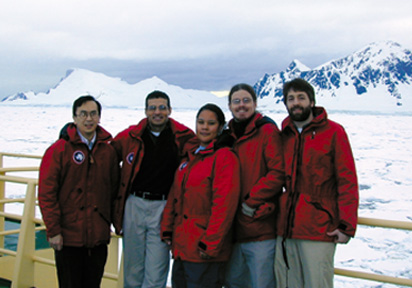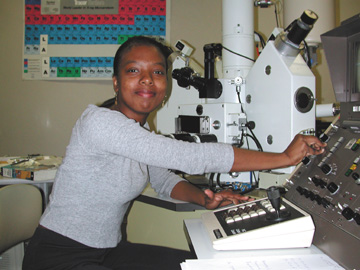
Geotimes Home | AGI Home | Information Services | Geoscience Education | Public Policy | Programs | Publications | Careers

 Last summer, President
Bush honored Antarctic researcher Philip J. Bart of Louisiana State University
(LSU) in Baton Rouge with the nation’s highest honor for professionals at
the outset of their independent research careers. Bart was the only geologist
of the 60 people given the 2001 Presidential Early Career Award for Scientists
and Engineers, and he considers the recognition “the highlight of my academic
career so far.”
Last summer, President
Bush honored Antarctic researcher Philip J. Bart of Louisiana State University
(LSU) in Baton Rouge with the nation’s highest honor for professionals at
the outset of their independent research careers. Bart was the only geologist
of the 60 people given the 2001 Presidential Early Career Award for Scientists
and Engineers, and he considers the recognition “the highlight of my academic
career so far.”  Keena Kareem
is also a graduate student at LSU and an AGI-MPP scholar for three years running.
She has taken her research to warmer climes, working with Gary Byerly at LSU to
investigate the chemistry and temperature of Earth’s early mantle using komatiite
minerals found in South Africa. Kareem presented her work as a poster presentation
last month at the Geological Society of America meeting in Denver. The
top graduating senior in geology from Tulane University in 1999, Kareem says her
professors Franco Marcantonio and Steve Nealson inspired her to become a geologist.
“I’ve always been amazed and fascinated with the universe and planets,”
she says. “I took earth science in junior high and enjoyed it, but after
eighth grade I had no dealings with geology until Tulane. It’s a shame I
didn’t have any geology classes in high school. I would have appreciated
it even more.”
Keena Kareem
is also a graduate student at LSU and an AGI-MPP scholar for three years running.
She has taken her research to warmer climes, working with Gary Byerly at LSU to
investigate the chemistry and temperature of Earth’s early mantle using komatiite
minerals found in South Africa. Kareem presented her work as a poster presentation
last month at the Geological Society of America meeting in Denver. The
top graduating senior in geology from Tulane University in 1999, Kareem says her
professors Franco Marcantonio and Steve Nealson inspired her to become a geologist.
“I’ve always been amazed and fascinated with the universe and planets,”
she says. “I took earth science in junior high and enjoyed it, but after
eighth grade I had no dealings with geology until Tulane. It’s a shame I
didn’t have any geology classes in high school. I would have appreciated
it even more.”
 |
Geotimes Home | AGI Home | Information Services | Geoscience Education | Public Policy | Programs | Publications | Careers |